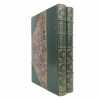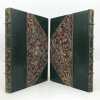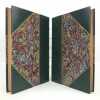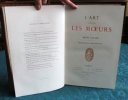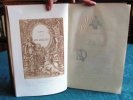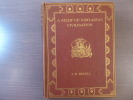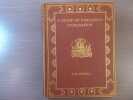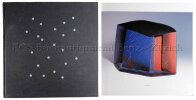-
Type
Any type (2)
Art print (7)
Book (31121)
Disk (1)
Drawings (7)
Engraving (9)
Magazine (130)
Old papers (1)
Photographs (14)
Posters (4)
-
Latest
Last 24h (1)
Last 3 days (15)
Last month (293)
Last week (45)
-
Language
Dutch (1)
English (54)
French (31195)
German (6)
Italian (18)
Japanese (2)
Portuguese (9)
Spanish (11)
-
Century
16th (16)
17th (56)
18th (210)
19th (1564)
20th (9430)
21st (1703)
-
Countries
Belgium (9472)
Brazil (7)
Canada (108)
China (3)
Côte d'Ivoire (63)
Denmark (215)
France (18339)
Germany (1)
Greece (1)
Italy (36)
Switzerland (3051)
-
Syndicate
ALAC (99)
CLAM (42)
CLAQ (94)
CNE (3)
ILAB (10813)
NVVA (1161)
SLACES (1161)
SLAM (8287)
SNCAO (9)
L'Art dans la Maison (grammaire de l'ameublement).
Paris, Librairie illustrée-Rouveyre, s.d. 205 X 300 mm. relié demi-chagrin marron à coins, dos à nerfs orné à chaud, tranches peignées. VI-411 pp. 4ème édition avec 269 figures et 50 planches. Ex-libris.
Phone number : 41 021 964 60 10
L’Art dans la maison (grammaire de l’ameublement).
1887 Paris, Édouard Rouveyre, 1887.
2 volumes in-4 (25 x 16,5 cm), demi-maroquin vert à coins (reliure de l’époque, signée par M. Ritter), dos à nerfs très joliment orné aux petits fers dorés avec fleurons mosaïqués, têtes dorées. viii-266-[2] ; [4]-246-[2] pages (complet). Quelques petits frottements et éraflures sur les dos et les plats, marges un peu brunies. Bon état. Nouvelle édition illustrée de très nombreuses gravures in-texte par Corroyer, Prignot, Goutzwiller, Favier, Kauffmann, Laurent, Toussaint, etc. La première fut publiée en 1884. Marie Alexandre Henry Havard (1838-1921), critique d'art et historien d'art français. Bon exemplaire.
L'art dans la Maison. (Grammaire de l'ameublement). Nouvelle édition, revue, corrigée et illustrée de 260 gravures par Corroyer, E. Prignot, Ch. Goutzwiller, Favier, Kauffmann, P. Laurent, H. Toussaint, etc.
Paris, Ed. Rouveyre, 1887 ; 2 vol. in-8 - VIII-265 - 1f.-246pp.-1f., 2 frontispices hors-texte en couleur. Demie percaline rouge, couvertures conservées. Parfait état.
Il s'agit de la 6ème édition, donnée en deux volumes dans un format plus petit que les précédentes parutions.
L'Art dans la maison (grammaire de l'ammeublement)
Librairie Illustrée, Edouard Rouveyre Relié 0 In-4 sous demi-reliure d'éditeur, dos orné, à 5 nerfs, illustrations noir et blanc et sépia, dans le texte et hors-texte de MM. Corroyer, C. David, E. Prignot, Favier, Fichot, Ch. Goutzwiller, Kauffmann, P. Laurent, Mikel, Henri Toussaint, etc., sans date ; nombreuses rousseurs, mors et coiffe supérieurs légèrement frottés, dos insolé, bel état. Livraison a domicile (La Poste) ou en Mondial Relay sur simple demande.
L'ART ET LE CONFORT DANS LA VIE MODERNE Le bon vieux temps
P, Flammarion , 1904 , in 8 br , XIV - 312 pp . Manque de paier au dos et sur la couverture , papier jauni Langue: Français
L'Art à travers les Moeurs.
Illustrations par C. Goutzwiller. 248 figures et 23 hors texte.Paris, G. Decaux et A. Quentin - 1882 - 404 pages. Ex-libris de la Bibliothèque de Louis Boutémy.Reliure plein chagrin rouge de l'époque. Dos à nerfs richement orné et doré. Plats ornés et dorés. Large dentelle bordant les contreplats. Tranches dorées. Un mors fendu sur 5cms. Menus frottements. Pas de rousseur. Bon état. Format in-4° (30x20).
GOUTZWILLER Charles
Les arts de l'ameublement, les styles
Delagrave. 1929. In-8. Broché. Etat d'usage, Couv. convenable, Coiffe en pied abîmée, Intérieur frais. 186p, illustré de gravures dans le texte de Toussaint et Hotin.. . . . Classification Dewey : 720-Architecture
7ème édition.Périodes gauloises, temps des Barbares, Le style roman, Renaissance, Style Louis XVI.... Classification Dewey : 720-Architecture
Dictionnaire de l'Ameublement et de la Décoration, depuis le XIII è siècle jusqu'à nos jours
PARIS, Maison Quantin, Compagnie Générale d'Impression et dÉdition, s. d. (1887) - EDITION ORIGINALE - Complet en 4 volumes in-4 carré (32,5 x 23 cm) - 1/2 Reliure rouge (très frottée, en partie déreliée) - Illustré de 256 planches hors texte dont certaines en couleurs et de plus de 2500 gravures dans le texte - T. I) VII + 1086 pages - T. II) 1250 pages - T. III) 1222 pages- T. IV) 1638 pages.
Ouvrage de référence
La France artistique et monumentale
. A la librairie illustrée Paris, sd. (vers 1898), 6 vol. petit in-folio, demi-chagrin maroquiné, marron, à coins, dos à 5 faux-nerfs, tête dorée. 207pp. Par volume. Ouvrage collectif sous la direction de Victor Havard. Nombreuses gravures sur bois en noir et 150 photographies ou reproductions d'oeuvres d'art, hors-texte, reproduites en héliogravure par Lemercier. T.I 25 héliogravures hors-texte. Articles sur : Reims, Versailles, Hotel Carnavalet, Brou, Pau, Avignon, Bagatelle.T.II 25 héliogravures. Le Louvre, Rouen, Fontainebleau, La Légion d'honneur, Amboise, Angers, Mont Saint Michel. T.III 25 héliogravures. Blois, Palais de l'Institut, Maintenon, Lyon, Hotel Soubise, Bourges, Aiguemortes, Cluny. T.IV 25 héliogravures. Paris, Vézelais, Nimes, Laon, Ecouen, Poitiers, Chambord, Meudon. T.V. 25 héliogravures. Amiens, Reims, Autun, Chantilly, Villebon,Bordeaux, Coucy, Pierrfonds, Vincennes, Saint-Antonin, Lyon. T.VI 25 héliogravures. Paris, Dijon, Chartres, Rouens, Orléans, Carcassonne, Chenonceau, Kermaria-an-Isquit. Qques rares et pales rousseurs sur qques pages. Coins très légèrement frottés sinon bon exemplaire de ce monumental travail sur notre architecture nationale. Les superbes héliogravures sont tirées sur papier vélin épais. Photographies numériques sur simple demande. Prévoir 15 euros de port pour la France.
moderne meubel.
Rotterdam, W.L. en J Brusse, 1924 Oorspronkelijk uitgevers omslag, 72 pagina's, met afbeelingen z/w. 16.5 x 21.4cm, prima staat.
De toegepaste kunsten een reeks monografie?n over hedendaagsche sier en nijverheidskunst. Dit is deel 5, Het moderne meubel. Eerste druk.
THE ANCIENT AND MEDIEVAL ARCHITECTURE OF INDIA: A STUDY OF INDO - ARYAN CIVILISATION.
John Murray London 1915 In-4 carré ( 260 X 195 mm ) de 230 pages, cartonnage rouille décoré de l'éditeur. Illustrations dans le texte, planches et cartes hors-texte. Très bel exemplaire.
Indian Sculpture and Painting. Illustrated by typical masterpieces with an explanation of their motives and ideals.
London, John Murray, 1908. Gr.-8°. XX, 278 S., (2) S. (Anzeigen). Mit 1 farb. Frontispiz und 78 z.T. farb. Tafeln. Goldgepr. Orig.-Leinenband (berieben und bestossen, Rücken minim gebräunt).
Fliegender Vorsatz mit handschr. Besitzereintrag. Durchgehend leicht gebräunt und teilw. stockfleckig. Buchblock mehrmals gebrochen.
Creative Copies : Interpretative Drawings from Michelangelo to Picasso
, Sotheby's Publications/ Meulenhoff/Landshoff 1988, 1988 Hardcover, 243 pages, ENG, 270 x 220 mm, book in fine order, with images / illustrations in colour and b/w. ISBN 9780856673504.
Italy's towering artistic achievement during the Renaissance is reflected in the magnificent collections in the Uffizi Gallery, the National Museum of the Bargello, and other galleries in Florence. In addition to the Old Masters, the Uffizi, a public gallery since 1765, contains masterpieces by Michelangelo, Leonardo da Vinci, Botticelli, Piero della Francesca, Giovanni Bellini, and Titian. The Bargello holds a superb collection of Florentine sculpture, with works by Michelangelo, Benvenuto Cellini, Donatello, and the Della Robbia family. The Pitti Palace houses an impressive collection of paintings by Raphael, together with about 500 important works of the 16th and 17th centuries collected by the Medici and Lorraine families.
THE ACHILLES SERIES,PART X - CORPUS RUBENIANUM LUDWIG BURCHARD THE ACHILLES SERIES,
, Brussels, Arcade, 1975, Bound, black cloth, illustrated dustjacket, + slipcase 180 x 265mm., 157pp. + 93 b/w plates. neuf/ fine condition.
volume X; The History of Achilles is a series of tapestries first commissioned by Rubens's second father-in-law Daniel Fourment, a tapestry-dealer in Antwerp. Very probably it was also Daniel Fourment who asked his famous son-in-law to provide the preparatory oil sketches, modelli and cartoons for the series. This cycle is not a very big project compared with other famous series designed by Rubens. Nevertheless, as Begemann puts is, " the excellence of the oil sketches and the modelli, and the sophistication of the artist's interpretation of the subject, make the series stand out as a major work ". In very good condition.
Een kerk van papier. De geschiedenis van de voormalige Mariakerk te Utrecht.
Zutphen, de Walburg Pers, 1985. In-8° br., couv. ill., 92pp., 30 fig. en noir in-t., bibliogr. notes et index (Clavis Kuntshistorische Monografieen, 2).
Etude sur l'histoire et l'architecture de l'église Sainte-Marie d'Utrecht. Avec un grand ex-libris calligraphié de Xavier Tremblay. Très bonne cond. - Frais de port : -France 4,95 € -U.E. 9 € -Monde (z B : 15 €) (z C : 25 €)
Havlicek, Josef - NAVRHY A STAVBY Projects and Constructions
, Prague: SNTL,, 1964 Original publishers -covered hardcover boards, 166 pages, oblong, 31x22cm. Illustrations bw ill. text in Czech .
Havlicek, Josef - NAVRHY A STAVBY Projects and Constructions / STATNI NAKLADATELSTVI TECHNICKE LITERATURY
I Eigtveds Tjeneste. Nogle Tanker om, hvordan arkitekten Nicolai Eigtved brugte sin Tommestok, da han byggede Amalienborg. Kbhvn., 1974.
Folio. Opapbd. 64 pp. Illustreret. Nr. 65 af 402 numm. eksemplarer, signeret. Plancher i lomme og ""tommestok"".
Hayashi Yasuo sakuhinshu The works of Yasuo Hayashi.
Tokyo, Kawade Shobo Shinsha, 1998. 4°. 197 S. Mit zum Teil farb. Abb. nach Werken von Yasuo Hayashi. Cloth binding in slipcase
With a dedication by the artist and a letter to Maya Behn from Yasuo and Teruko. Also included a set of 8 colored photograhs the launch of this book.
The Power of Place. Urban Landscapes as Public History
The MIT Press 1995 Edition en Anglais. English Book. In-8 relié 25 cm sur 18,5. Jaquette en assez bon état. 296 pages. Très bon état d’occasion.
Le pouvoir du lieu. Les paysages urbains comme histoire publique Très bon état d’occasion
Ambiances d'artistes.
Editions de la Martinière 2008 1 vol. relié in-4, cartonnage éditeur, jaquette, 190 pp., nombreuses reproductions en noir et en couleurs. Etat de neuf.
VIEILLES MAISONS FRANCAISES N°148 - ÉDITORIAL,par Georges de Grandmaison.VAUCLUSE, LE PAYS QUI A VU LES PAPES,par Michel Hayez.MAISONS ROMAINES,par Yves de Kisch.CHÂTEAUX DE SOLEIL,par Frédéric d'Agay.RENCONTRES ITALIE-FRANCE
VIEILLES MAISONS FRANCAISES. JUIL 1993. In-12. Broché. Bon état, Couv. convenable, Dos satisfaisant, Intérieur frais. 128 pages. Nombreuses photos en couleur et noir et blanc dans et hors texte.. . . . Classification Dewey : 720-Architecture
Sommaire : ÉDITORIAL,par Georges de Grandmaison.VAUCLUSE, LE PAYS QUI A VU LES PAPES,par Michel Hayez.MAISONS ROMAINES,par Yves de Kisch.CHÂTEAUX DE SOLEIL,par Frédéric d'Agay.RENCONTRES ITALIE-FRANCE-COMTAT,par Marie-Claude Léonelli.INTÉRIEURS PEINTS,par Anne-Marie Peylhard.FOI ET ARCHITECTURE,par Andréas Hartmann-Virnich.HÔTELS AVEC COUR,par Marie-Odile Giraud.IMAGES DE POUVOIR,par Isabelle Battez.GARDONS MAS ET BASTIDONS,par Erik Fannière.EAUX VIVES,par Bruno Lalleraand.POUR VIVRE HEUREUX, VIVONS PERCHÉS,par Catherine Bourlet et Bruno Lallemand.L'EAU, LE FER ET L'OCRE,par Jean-Pierre Locci.À VOIRen Vaucluse.CARTE MANIFESTATIONS CULTURELLESJURIDIQUEL'exportation des biens culturels, par Pierre-Laurent Frier.ACTUALITÉLa page de l'Europe.SAUVEGARDEREyrignac, un jardin d'aujourd'hui, par Jean Lafond Grellety.Décor peint resurgi à Busset, par Pierre de Lagarde.LIRELu pour nous, par Éric Ollivier.Sélection VMF.S'INFORMERPatrimoine.Expositions.VMF en bref. VMF Jeunes.35e anniversaire des VMF.Palmarès des prix VMF 1993. Friends of VMF. Liste des délégués. Activités départementales.Carnet. Annonces. Classification Dewey : 720-Architecture
Commentarii in prophetas minores e schola Autissiodorensi, pars prima. Commentarii in Osee, Ioelem, Amos, Abdiam
, Brepols, 2021 Hardback, 427 pages, Size:155 x 245 mm, Language(s):Latin, French. ISBN 9782503596594.
Summary Haymon, moine prof s de Saint-Germain d'Auxerre, y dirigea l' cole abbatiale au milieu du IXe si cle. Haymon avait entrepris de commenter la s rie des Douze proph tes, mais, comme son commentaire d'Ez chiel, cette entreprise est rest e inachev e. Haymon n'a expliqu que les quatre premiers petits proph tes ; les huit autres l'ont t par son confr re Heiric (CC CM 135G, 2020), qui fut son l ve, puis son successeur la direction de l' cole de Saint-Germain d'Auxerre. Au contraire de ceux-ci, transmis en bloc par une tradition uniforme, les quatre commentaires compos s par Haymon l'ont t , du moins au d part, de fa on dispers e. Ainsi s'explique que les commentaires authentiques de Jo l, Amos et Abdias fassent d faut dans une partie de la tradition manuscrite, o ils ont t remplac s tant t par les commentaires de J r me, tant t par des commentaires m di vaux anonymes, mais anciens, qui sont galement dit s dans ce volume.
Emiel Veranneman. 50 Jaar Meubelcreaties.
, Gemeentekrediet, 1994 Bound in Or. gilt stamped halfcloth with dustwrapper 325 Pages 33 x 25,5 cm. text in Nederlands / Dutch. ISBN 9050661335.
50 jaar te kortrijk, les saisons bruxelloises, 50 jaar stichting en als binnenhuisarchitect en meubelontwerper.Met bijdragen van o.a. Hugo Claus, M. Duchateau, J. Meuris, K.J. Geirlandt and L. Daenens. With numerous full-page illustrations (for a great part in colour), facsimiles, an index, a biography and a bibliography.
Wendingen: Landhuizen, 12de serie, nummer 4 (1931)
Amsterdam, .C.A.Mees,, Santpoort, 1931 Softcover, japanse binding, 18 pagina's, 33.5 x 33.5 cm.
Nummer 4 van de 12de serie gewijd aan landhuizenarchitectuur.
WENDINGEN - Nummer 2 van de 11e serie (1930), gewijd aan de architektuur van kantoor en fabrieken...Van Nelle Rotterdam
Amsterdam, Wendingen, 1930 Softcover, Japanse binding, 30 pagina's, 33.4 x 33.6 cm. * in prima staat!
WENDINGEN - Nummer 2 van de 11e serie (1930), gewijd aan de architektuur van kantoor en fabrieken...Van Nelle Rotterdam
 Write to the booksellers
Write to the booksellers